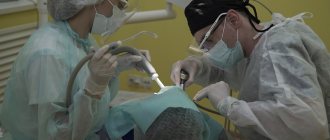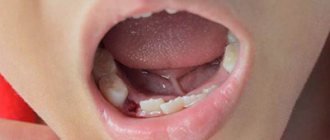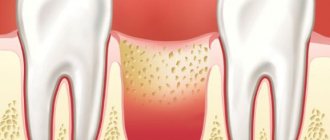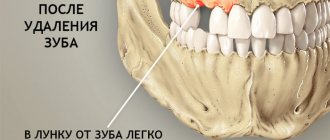- When is it necessary to remove the lower wisdom tooth?
- Tooth eruption problems. Wisdom teeth removal in advance
- Indications and contraindications
- Preparation for the procedure
- Removal steps
- Possible complications after removal
- Time and prices for the procedure
- Advantages of treatment at Aurora
Removal of a wisdom tooth on the lower jaw
Most people of conscious age go to the dentist because of problems with their lower wisdom teeth.
They often interfere, put pressure on neighboring molars, and cause discomfort or pain after eating. Most often, wisdom teeth in the lower jaw appear between the ages of 20 and 25, although the timing varies from person to person; for some, they may appear at the age of 16, for others closer to 40 years. In most cases, the appearance of figure eights is accompanied by various complications that require their removal. Malocclusion, difficulty in teething, tumors and trauma to the mucous membrane and much more.
When is it necessary to remove the lower wisdom tooth?
Eighth teeth are removed in two cases: when they have not yet sprouted or are already protruding from the gums. In the first case, the operation is performed if the patient feels discomfort, and during an external examination the doctor does not see diseased teeth. The appearance of pain means that the molar in the gum is pressing on its neighbor and disturbing him.
If the wisdom tooth has erupted incorrectly - that is, not straight up, but with a deviation, at an angle to the jaw and neighboring teeth, then removal is also a mandatory procedure. The slope of the figure eight is:
- distal - when the “eight” is tilted back, away from the “seven”. In this case, there is a risk of injury to the gums and damage to the roots of the adjacent tooth;
- medial - when the “eight”, on the contrary, is inclined towards the neighboring tooth. This increases the likelihood of damage to the crown part of the “seven” and the development of caries on both teeth;
- buccal – in this case, the wisdom tooth is turned towards the cheek and constantly touches the mucous membrane, causing irritation and hardening of the tissues. This condition can eventually lead to the formation of a tumor on the mucosa.
The removal of a wisdom tooth in the lower jaw is definitely necessary in the following cases:
- Caries on a wisdom tooth.
- Lack of space in the row for teeth. The last molars put pressure and cause discomfort.
- Pain in the gum where the wisdom tooth is located, at any time of the day, even after sleep.
- Incorrect growth sideways towards the tongue or larynx. This phenomenon is called dystopia.
- It interferes with implantation.
A tooth can erupt without causing pain once it appears; it will still be removed because it is not growing properly. The dentist makes an accurate diagnosis. To make an appointment, leave a request on the website or call one of the numbers: +7-924-444-05-45 - administrator
Removing a wisdom tooth in the lower jaw is a more complex procedure than removing an upper tooth. The bottom eights have a more powerful root system, and the jaw bones are denser and thicker. To remove a lower molar, it is necessary to perform a complex operation with dissection of the gum. In some cases, the surgeon has to remove part of the bone, divide the root into several parts and extract them separately.
Sign up for a free consultation
Pain in the tooth socket after extraction
If the tooth extraction operation is adequately carried out and all the dentist’s recommendations are followed, then after a couple of days the tooth socket should heal painlessly. A plaque forms at the site of damage, which is gradually covered by epithelial tissue as new bone tissue begins to grow.
And if pain persists after these days, it means that due to a combination of circumstances, inflammation has begun in the injured area (alveolus). In medical terminology, this process is called post-extraction alveolitis or alveolitis of the socket.
Etiology of alveolitis
After the tooth is removed, the created cavity should be filled with blood, which after a short time will transform into a special blood clot. Such a clot forms a biological barrier against all kinds of mechanical damage and infection.
But in some cases, the integrity of the blood clot is disrupted or for some reason it is completely absent, then the healing process is disrupted. In this regard, the development of alveolitis of the socket begins, which appears already on the third day and is accompanied by pain.
The main reasons for its occurrence and development are considered to be:
- Incorrectly performed surgery with violations of antiseptic rules, involuntary involvement of dental plaque in the socket, etc.
- Insufficient treatment of the postoperative socket, as a result of which small particles of tooth or pathological tissue remain in it.
- Complexity of the operation.
- Insufficient or complete absence of outpatient procedures for oral care recommended by a doctor.
- Failure to comply with simple hygiene standards.
- Eating food (especially spicy, hot or rough) before the recommended time.
- Self-medication by rinsing on the day of removal.
- Smoking in the first hours after tooth loss.
- Weak immune defense of the body.
- A number of common diseases that can affect the development of the inflammatory process.
Post-extraction alveolitis is dangerous due to severe consequences and complications. Therefore, this procedure must be approached responsibly and trusted to experienced and adequate specialists.
Symptoms and their manifestation
Usually, with a “dry” socket (no blood clot), the inflammatory process begins quite quickly after removal. Residues of food and saliva may be observed in an unprotected formation. Redness of the nearby gums is noticed, touching which causes pain.
If you do not seek medical help in time, the symptoms become more noticeable and are accompanied by:
- not soothing, rather severe pain in the damaged area;
- general condition worsens with rising temperature;
- a feeling of pain spreading throughout the entire jaw;
- the appearance of pus in the wound, resulting in a purulent odor from the mouth;
- formation of black plaque on the gum and socket;
- The submandibular lymph nodes gradually enlarge.
Emergency treatment at home
If the first signs of alveolitis appear and you cannot see a doctor within two to three days, you can try to alleviate the symptoms of the disease yourself.
It is important to remember that not all methods, drugs or folk remedies can cause relief. Some may even make the condition worse. For example, such well-known antiseptics as hydrogen peroxide or soda, on the contrary, will clean the infected hole beyond recognition, freeing it from blood clots, so that it will remain completely defenseless for infections.
If you can contact a specialist, you can use some types of analgesics to relieve pain. These include Baralgin, Ketanov or something similar. To relieve inflammation, you can rinse with a weak solution of potassium permanganate or furatsilin.
But natural antiseptics can be the most effective at home. Consider some folk recipes that have worked well for this disease.
Remedy No. 1
The herbal mixture has a good effect. Flax seed, blessed knycus, creeping tenacious (grass), blue cornflower (flowers), oregano, sunflower petals, are crushed and mixed in equal proportions. Then a spoon (tablespoon) of the crushed collection is filled with one glass of boiling water. The hour is running out. The strained mixture is divided into 4 doses and drunk throughout the day. Good reviews when using this decoction in the form of inhalation.
Remedy No. 2
Pour two tablespoons of St. John's wort (herb) and a spoonful of chamomile (flowers) into half a liter of boiling water and leave covered for two hours. Strain the resulting mixture and rinse your mouth with it at least every hour.
Remedy No. 3
A spoonful of medicinal sage is poured into a glass of boiling water. Brew for an hour in a thermos or wrapped in a thick thick cloth. After straining, rinse your mouth as often as possible throughout the day.
Remedy No. 4
A spoonful of dried chamomile flowers is poured into a glass of boiling water and steamed in a thermos for half an hour. Carefully filter and use as a rinse throughout the day.
Remedy No. 5
A decoction made from calendula (flowers) has an effective effect. A spoonful of flowers is poured with 200 ml of boiling water and steamed for half an hour. Then strain and rinse all day.
Of course, traditional methods of treatment can be effective, but it is better not to do without consulting specialists.
Tooth eruption problems. Wisdom tooth removal in advance
Many patients think that if the wisdom tooth is not visible on the gum, then there is no need to worry. However, over time, this molar increases in size and begins to interfere with the others. Waiting until the wisdom molar appears can lead to the following problems:
- pain in the tooth and gum;
- caries between molars;
- curvature of the roots of a healthy chewing tooth;
- infection in the place where the molar erupts because it grows incorrectly;
- curvature of the bite.
It is easier for a doctor to pick up and remove a tooth that has not yet come out. So while there is no pain, it is better to have surgery in advance.
Indications and contraindications
The attending physician (therapist) or orthodontist directs the removal of a molar in the lower jaw. In any case, the patient is sent for a panoramic photo, where the location of the teeth is visible. This procedure facilitates the work of the surgeon who has to deal with a complex operation. Contraindications for removal are as follows:
- Pregnancy and breastfeeding. After such a complex removal, the mother will have to stop breastfeeding, because antibiotics and painkillers can get into the baby along with the milk.
- People of the older generation with a diseased heart, hypertension of the 2nd or 3rd degree should be attentive to their health and not rush into surgery, but it is better to refuse it altogether.
- Malignant formation in the tooth growth zone.
Tooth extraction is also done as a preventive measure in advance, so that later they do not hurt and do not interfere with others.
Preparation for the procedure
Before removing a tooth, it is necessary to undergo a computed tomogram (CT ). The device allows you to illuminate the teeth and see the location of the crowns and roots in the gums. CT will make the surgeon’s work easier and save him from a long and complex operation. The procedure is painless. Done quickly.
The choice of tooth extraction technique depends on several factors:
- the presence or absence of inflammation of the soft tissues surrounding the tooth,
- duration of the process,
- location of the third molar in the bone,
- contacting a doctor during periods of exacerbation or remission of the disease,
- degree of tooth crown destruction.
Why does my gum hurt?
Unexpressed aching pain and slight swelling of the gums appear due to injuries to soft tissues, nerves, and jaw bone when removing a tooth from its bed. The gum tissue swells, the nerve endings are compressed, hence the pain. How much your gums hurt after tooth extraction depends on:
- Patient's pain sensitivity;
- degree of complexity of the intervention;
- features of the clinical case;
- location of the dental unit (after extraction of molars, the injury is greater, the pain lasts longer);
- state of immunity.
The body’s normal response from the development of complications is distinguished by the following properties: the pain does not intensify, pathological symptoms are present for no more than 7 days, and no other signs of deterioration in well-being are observed.
Removal steps
The procedure can be divided into three stages:
- preparatory;
- The operation itself;
- After surgery.
Preparatory stage.
At this stage, the doctor visually examines the patient's oral cavity. Then a computed tomography is done to look at the length and shape of the roots, the depth of the tooth, etc.
Surgery
Complex wisdom tooth removal is divided into several stages. Let's consider a generalized operation scheme:
- A painkiller is given. To do this, a needle is inserted into the lower jaw to the nerve bundle so that the patient does not feel pain. Lips, chin, tongue are numbed. If sensitivity does not disappear, an additional injection is given. After anesthesia, the course of a complex extraction procedure depends on the location of the tooth.
- An incision is made with a scalpel.
- The tooth is sawed down to make it easier to remove.
- Take out the crown and roots.
- The wound is treated and sutured.
This completes the surgical stage.
Postoperative stage
This stage is very important, its duration is 7 – 10 days. During this period, the surgical wound heals, and a clot first forms in the hole and then resolves. Patients must follow our doctor's instructions exactly to avoid post-operative complications.
Tooth extraction: how long does the procedure take?
With a simple type of extraction, the procedure is carried out in 10 - 20 minutes. The process of complex removal lasts from 30 minutes or longer, depending on the specifics of the operation. For example, removing a horizontal tooth can take up to 2 hours or more. At the same time, sometimes additional preparatory procedures are necessary, which also take time.
After tooth extraction in the lower jaw antibiotics to prevent the entry and spread of infection. Such complex manipulations are contraindicated for pregnant and nursing mothers. Painkillers are prescribed to reduce pain after the procedure.
For complex removal, the patient is asked to come back again in five days or earlier if a fever appears. If the tooth has come out halfway (semi-retinated tooth), removal is carried out in the same way, but it is easier to pull it out, since part of the molar is on the surface.
How to get rid of pain at home
To eliminate postoperative pain, the dentist will prescribe analgesics and cold compresses on the side of the intervention. Additionally, you can use traditional methods - mouth baths made from tinctures or herbal decoctions. Baths with an antiseptic drug are also allowed (the solution must be held in the mouth for a while and spat out). What is strictly forbidden:
- warm the operated area;
- rinse your mouth intensively (you can wash out the blood clot);
- chew on the injured side;
- “check” the hole using your tongue, fingers, and apply medicine to it.
The risk of complications depends on the complexity of the operation to remove a dental unit. Simple extraction is carried out if the tooth does not have strong, intertwined roots, it is intact, and there are no associated problems (cysts, pulpitis, periodontitis, etc.).
Extraction of dystopic teeth, which are very crooked, have intertwined, crooked roots, with a destroyed coronal part, and with an inflammatory process, is considered difficult. In such cases, a more extensive operation may be necessary with a preliminary incision in the gum, sawing the tooth into elements, extracting fragments through a hole in the jaw bone, and applying sutures. Molars are usually difficult to remove. If your gums hurt for several days after the removal of a molar, but the painful symptoms are smoothed out, then the wound is healing normally.
Possible complications after removal
Complications after surgery arise due to violations of doctors’ recommendations. Patients begin to rinse their mouth, go to the bathhouse, play sports, or do not take medications that were prescribed. It is absolutely IMPOSSIBLE to do this for 5 days, because the place where the tooth was located is easily inflamed. Pain after removal is normal. Because the anesthesia wears off and the gums heal. Taking painkillers reduces pain.
Without taking antibiotics, inflammation and suppuration may begin. This situation arises due to the fact that food often accumulates at the end of the gums, which is difficult to remove with a brush, and along with it remain microbes that cause suppuration.
If bleeding occurs after removal, you should press the wound with a cotton pad for 15 minutes. If the bleeding does not stop, you should consult a doctor.
For reference! For high-quality and rapid healing, it is necessary that the wound heals well, so you should not eat hard food for at least 5 days and clean the hole.
How long does your gum hurt after tooth extraction?
Normally, after 1-3 days, tissue swelling gradually decreases, pain goes away, and health improves. Already on the 3-4th day, the blood clot is gradually replaced by granulate, and after a week it fills the entire hole. After tooth extraction in the upper jaw, the recovery time is identical to the lower jaw, but bone regeneration in the upper dentition occurs more slowly.
In some clinical cases, the surgeon may cut the gum and drill out the jaw bone. Typically, such manipulations accompany the extraction of the outer eighth molars (wisdom teeth). Then healing takes longer than after a simple operation.
If 5-7 days after the intervention the pain does not decrease, but rather becomes more intense, you should consult a doctor. Acute, nagging, constant pain after tooth extraction can be a symptom of complications.
The tooth socket heals in approximately 2-4 weeks. Recovery time depends on the parameters of the wound and the body’s reaction to the removal procedure. Bone volume is restored approximately 6 months after the intervention.
Time and prices for the procedure
This complex operation takes about an hour. The duration of the procedure depends on the complexity of the figure eight position and the degree of neglect.
The consultation is free of charge. The final cost can be found out after consulting a specialist.
| Name of service | Unit | Price |
| Primary appointment (examination, consultation) with a dental surgeon | units | 0 |
| Repeated appointment (examination, consultation) with a dental surgeon | units | 500 |
| Complex tooth extraction with root separation | units | 7000 |
| Removal of periodontitis tooth | units | 2000 |
| Removal of a permanent tooth | units | 4000 |
| Flap surgery in the oral cavity in the area of the 1st tooth | units | 2000 |
| Flap surgery in the oral cavity on periodontal tissues (convet flap displacement) | units | 6000 |
| Removing stitches | units | 200 |
| Suturing the oral mucosa | units | 500 |
| The operation of removing an impacted, dystopic or supernumerary tooth | units | 8000 |
| Stopping alveolar bleeding without suturing using hemostatic materials | units | 500 |
A detailed price list can be found on the website.
Tissue damage
During extraction, soft tissue is inevitably damaged. Sometimes the doctor even has to cut the gum to gain access to the unerupted crown. Until complete healing, the wound may be slightly painful, and the tissue around it will remain red and swollen for some time. The pain can radiate to neighboring crowns or even ears. If the discomfort becomes less pronounced every day, swelling and redness subside, there is no need to worry.
You should urgently seek medical help if:
- inflammation and pain intensify,
- not only the soft tissues in the oral cavity swelled, but also the cheek,
- there was an unpleasant taste in the mouth,
- pus is released from the wound.
All this indicates inflammation of the tissue in the hole.
Make an appointment for lower wisdom tooth removal
Byshlyaga Dmitry Yurievich
Byshlyaga Dmitry Yurievich Orthopedic dentist
Extensive practical experience. Regularly undergoes internships and advanced training courses.
Working hours: from 9.00 to 20.00, daily, seven days a week, by appointment
Make an appointment
More details
Asatryan Alexander Aramovich
Asatryan Alexander Aramovich Dentist therapist - orthopedist - surgeon
Extensive practical experience. Regularly undergoes internships and advanced training courses.
Working hours: from 9.00 to 20.00, daily, seven days a week, by appointment
Make an appointment
More details
×
Advantages of treatment at Aurora
Removing the lower wisdom tooth is a complex procedure that requires high specialist competence. Due to the inconvenient location and improper growth of the last molar, neighboring teeth suffer. Highly qualified specialists of our center easily and quickly carry out complex operations of this level. In addition, Aurora dentistry has other important advantages over its competitors:
- the possibility of receiving installments from Pochtabank or Renaissance Credit;
- individual approach;
- work on weekends, including for residents of the region by appointment;
- The doctor is assisted by an assistant, which allows him to carry out manipulations 2 times faster;
- modern, 100% high quality, imported materials.
Our dentistry offers the following promotions for the removal of the lower wisdom tooth:
- If you found out about us through 2GIS, we provide 5% on services;
- 10% discount on your birthday and the next 3 days
- For pensioners there is a “Golden Watch” promotion - a 10% discount on tooth extraction from 9-00 to 11-00
If you need complex and long-term dental treatment in Blagoveshchensk, we have an individual discount policy and a flexible payment schedule
To make an appointment, just call. On the appointed day, the doctor will see the patient and tell him how the lower wisdom tooth will be removed without pain after the procedure and fear.











